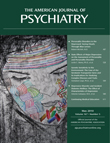Association of Depressed Mood and Mortality in Older Adults With and Without Cognitive Impairment in a Prospective Naturalistic Study
Abstract
Objective
The authors examined predictors of mortality in individuals age 50 or older with or without cognitive impairment in a 12-year prospective naturalistic study of subcortical ischemic vascular disease focusing on symptoms of depressed mood, apathy, anhedonia, or anergia.
Method
A total of 498 participants were recruited from the community and from memory clinics into a multicenter longitudinal study of subcortical ischemic vascular disease. For baseline cognitive status, 36% of participants were assessed as cognitively intact, 31% as cognitively impaired, and 33% as demented. All participants underwent a research protocol MRI, and 41% were classified as having subcortical lacunes. Depressed mood, anhedonia, anergia, and apathy were assessed at baseline using a structured behavioral assessment. Cox regression models were used to investigate the associations between neuropsychiatric symptoms and mortality, controlling for age, gender, race, education level, cognitive status, presence of vascular lacunes, and vascular risk factors.
Results
Of 498 participants, 175 (35%) died over the follow-up period, with a median survival time of 5.6 years. In the multivariate analyses, cognitive impairment, age, male gender, depressed mood, and the presence of lacunes predicted higher mortality. Participants with both lacunes and depressed mood had the shortest survival among all cognitive groups. The mortality hazard ratio for participants with depressed mood was 2.2 (95% CI=1.5–3.2) after adjustment for cognitive status, age, gender, education level, race, lacunes, and all vascular conditions.
Conclusions
These findings suggest the importance of detecting depressed mood in individuals with cerebrovascular disease and of developing more aggressive treatment and preventive interventions for this vulnerable population.



